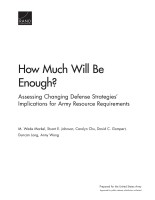| 来源类型 | Research Reports
|
| 规范类型 | 报告
|
| 来源ID | RR-239-A
|
| How Much Will Be Enough? Assessing Changing Defense Strategies' Implications for Army Resource Requirements |
| M. Wade Markel; Stuart Johnson; Carolyn Chu; David C. Gompert; Duncan Long; Anny Wong
|
| 发表日期 | 2014
|
| 出版年 | 2014
|
| 页码 | 168
|
| 语种 | 英语
|
| 结论 |
The Strategic Investment Analysis Protocol (SIAP) can be used to estimate the resource implications for the Army of changes in national defense strategy.- SIAP estimates costs for both the operational Army and the generating Army.
- SIAP cost estimates include support and sustainment forces.
- SIAP can be used to assess the degree to which Army investment options are robust across alternative defense strategies.
The authors estimate the costs of three alternative defense strategies to illustrate SIAP.- The Direct Counterinsurgency (COIN) strategy approximates the strategy that was current at the time of this study. Maintaining an Army to support this strategy over a 20-year period would cost over $3.2 trillion.
- The Build Local Defend Global strategy assumes that the primary threats to the United States arise from instability and that the United States can mitigate these threats by developing partners' capabilities for governance. Maintaining an Army to support this strategy would cost approximately $2.2 trillion over the same period.
- The Rising Peer strategy assumes that only a major peer or near-peer competitor, such as China, can threaten the security of the United States. The Army supporting this strategy would also cost about $2.2 trillion.
SIAP provides Defense Department and Army leaders with the means to assess the costs of alternative strategies before they select one. - SIAP can provide relatively accurate, first-order estimates of the resource implications for the Army of alternative defense strategies.
- It can give senior leaders more precise guidance with which to initiate the force management requirements process.
- Because SIAP trades precision and accuracy for responsiveness, it cannot substitute for ordinary planning and budgeting processes in providing a detailed and specific analysis of what is actually needed to implement a particular strategy.
|
| 摘要 |
- The Army should use relatively accurate, first-order estimates of resource implications to inform the development and selection of defense strategies and the Army investment options that support those strategies.
- The Army should adopt SIAP as a cost estimation method.
|
| 主题 | Military Budgets and Defense Spending
; Military Strategy
; United States Army
; United States Department of Defense
|
| URL | https://www.rand.org/pubs/research_reports/RR239.html
|
| 来源智库 | RAND Corporation (United States)
|
| 资源类型 | 智库出版物
|
| 条目标识符 | http://119.78.100.153/handle/2XGU8XDN/107706
|
推荐引用方式
GB/T 7714 |
M. Wade Markel,Stuart Johnson,Carolyn Chu,et al. How Much Will Be Enough? Assessing Changing Defense Strategies' Implications for Army Resource Requirements. 2014.
|
|
文件名:
|
x1495315148616.jpg
|
|
格式:
|
JPEG
|

|
文件名:
|
RAND_RR239.pdf
|
|
格式:
|
Adobe PDF
|
除非特别说明,本系统中所有内容都受版权保护,并保留所有权利。